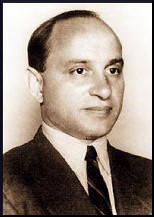Semyon Semyonov

Semyon Semyonov was born in Odessa, Russia, in 1911. He graduated with an engineering degree from the Moscow Textile Institute in 1936. Semyonov (code-name Twen) joined the NKVD and in January 1938 he was sent to the United States. (1) He enrolled at the Massachusetts Institute of Technology, from which he graduated in June 1940. He later commented: "I did not regard studying there as a goal per se, but as a way of preparing for intelligence work, learning about the country and the language and increasing my general technical knowledge." (2)
Alexander Feklissov worked with Semyon Semyonov in the United States: "Short, with a duck nose and big eyes which, while he was talking to somebody, revolved like parabolic antennas... he was quick at getting along with people... and could easily be taken for a middle-level American businessman." (3)
Semyon Semyonov - Soviet Spy
In 1942 Semyonov discovered that Jacob Golos was working with a group led by Julius Rosenberg, in the field of technical intelligence. He managed to persuade Vassily Zarubin to let him take over the group. "I determined that it had great potential possibilities in the field of radio-engineering and aviation. Therefore, I brought the station chief's (Zarubin's) attention to the matter of the giving me (Rosenberg) with his group, which was done despite a certain resistance on (Golos's) part. In the person of (Rosenberg), I found a young party member willing to render technical help to our country using channels of the fraternal organization (CPUSA). He was absolutely unripe in matters of working as an agent, our demands regarding the type of materials we acquire, and elementary rules of konspiratsia. His group worked on the principles of a Communist party group, and (Rosenberg) ran it as a party organizer." (4)
Harry Gold
Semyon Semyonov became the contact officer of Harry Gold. Gold became someone who Moscow considered a "very valuable worker" for Soviet intelligence. Gold was so busy as a courier to hold down his day job as a chemist. In the summer of 1942, the station began paying him $100 monthly to supplement his income. Semyonov now met with Gold once or twice a week. (5) In June 1943, Gold was assigned the additional job of running an operation code-named Sulpho, aimed at acquiring materials on biological warfare.
It was noted by NKVD that Robert Oppenheimer was the supporter of radical causes before the Second World War. Semyonov was told to try and recruit Oppenheimer. A report stated: "Oppenheimer represents a very large interest for us... His friendly attitude toward our country provide grounds for counting on a positive result of his cultivation. According to data we have, (Oppenheimer) has been cultivated by them, it is necessary to have him passed to us. If the recruitment is not realized, we must get from the neighbors all materials on Oppenheimer) and begin his active cultivation through channels we have." (6) A report by Anatoly Gorsky suggests that the NKVD was never successful in recruiting Oppenheimer. (7)
Investigated by the FBI
Semyon Semyonov came under FBI surveillance in the spring of 1944. It was therefore decided to transfer his spy network to Alexander Feklissov. He later recruited other spies. On 21st September, 1944, he described the abilities of David Greenglass and Ruth Greenglass: "They are young, intelligent, capable, and politically developed people, strongly believing in the cause of communism and wishing to do their best to help our country as much as possible. They are undoubtedly devoted to us." (8)
Semyonov returned to the Soviet Union and after an assignment in France he was promoted to the rank of lieutenant-colonel. He was dismissed from the service and worked as a translator in the publishing house Progress.
Semyon Semyonov died in 1986.
Primary Sources
(1) Semyon Semyonov, report to Moscow (November, 1944)
In 1942, I learned that (Golos) was working with a group of local compatriots in the field of technical intelligence. From the Center's letters, one could conclude that nothing was known about the group and that it was providing desultory materials rated low in importance... I determined that it had great potential possibilities in the field of radio-engineering and aviation. Therefore, I brought the station chief's (Zarubin's) attention to the matter of the giving me (Rosenberg) with his group, which was done despite a certain resistance on (Golos's) part. In the person of (Rosenberg), I found a young party member willing to render technical help to our country using channels of the fraternal organization (CPUSA). He was absolutely unripe in matters of working as an agent, our demands regarding the type of materials we acquire, and elementary rules of konspiratsia. His group worked on the principles of a Communist party group, and (Rosenberg) ran it as a party organizer.
References
(1) Allen Weinstein, The Hunted Wood: Soviet Espionage in America (1999) page 173
(2) Venona File 40129 page 202
(3) Alexander Feklissov, Behind the Ocean and on the Island (1994) page 56
(4) Semyon Semyonov, report to Moscow (November, 1944)
(5) Venona File 86194 page 348
(6) Venona File 82702 page 143
(7) Venona File 82702 pages 422-423
(8) Allen Weinstein, The Hunted Wood: Soviet Espionage in America (1999) page 177
